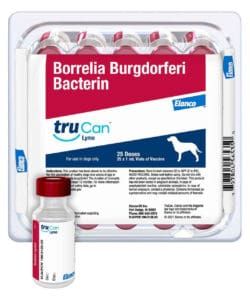Lyme disease is the most commonly reported tick-borne disease in dogs. Fortunately, we can help protect our dogs from Lyme disease with preventive measures and using a vaccine sometimes called a “tick shot for dogs.” Of course, this is a vaccine that is only effective against Lyme disease in dogs, not all tick-borne diseases.
Tick-borne diseases are on the rise, including Lyme disease. You can help protect your dog from ticks and Lyme disease if you:
- Use a highly effective flea/tick preventative.
- Wear tick-repellent clothing.
- Promptly check for and manually remove attached ticks from our dogs; it takes 24 to 48 hours for attached ticks to transfer the disease.
- Give the Lyme disease vaccine for dogs.
As a veterinarian and dog owner, I feel strongly that the canine Lyme vaccine is safe and effective enough for dogs who live in areas that are endemic for Lyme disease.

I religiously give my dog Prince a dose of Nexgard every 30 days. I check him for ticks after we have been hiking in the woods. He wears a Seresto collar and an Insect Shield T-shirt or neck gaiter if we are visiting an area with a really high tick population. And I vaccinate him annually for Lyme disease.
Despite everything I do to protect him from tick-borne diseases, I was shocked last spring to find that he tested positive for exposure to Anaplasma, another tick-borne bacteria that can cause a disease called anaplasmosis. Thankfully, his Anaplasma antigen test was negative, meaning that his body had cleared the infection on its own. But I was still flabbergasted to find that I could not 100% protect him.
Most dogs who contract Lyme disease remain normal through the course of the disease, according to the Companion Animal Parasite Council. However, dogs who do show signs of an acute infection may experience fever, shifting leg lameness, swollen joints, enlarged lymph nodes, lethargy, depression, and loss of appetite. They usually improve quickly once treatment with antibiotics has begun. Dogs with chronic infections may exhibit shifting leg lameness caused by polyarthritis (inflammation affecting joints in more than one limb), which may persist even in the face of aggressive antibiotic therapy. Only about 1% to 5% of dogs who are infected with Lyme disease suffer from the most serious effect of s Lyme nephritis – damage to the kidneys. This condition is often fatal despite treatment.
Efficacy rates for canine Lyme vaccines have been reported within a range of 50% to 90%. Effectiveness of the vaccines appears to increase with each booster. No vaccine is 100% effective.
Lyme Vaccine Side Effects

Lyme vaccines confer protection to our dogs against the bacteria that causes Lyme disease, Borrelia burgdorferi (see “How Does the Lyme Vaccine for Dogs Work?,” below). The initial series is two vaccines given two to three weeks apart. After the initial series, the Lyme vaccine is administered once a year.
Decades ago, the Lyme vaccine earned a reputation for causing side effects in dogs. A 2005 study reported that the incidence of acute adverse events in dogs within 3 days of vaccinations for any disease was highest for those receiving a B. burgdorferi bacterin vaccine (43.7 incidents per 10,000 doses) compared with all other vaccines examined. No newer studies have been reported, but considerable advances have been made in vaccinology in recent years.
Lyme vaccines confer protection to our dogs against the bacteria that causes Lyme disease, Borrelia burgdorferi. The initial series is two vaccines given two to three weeks apart. After the initial series, the Lyme vaccine is administered once a year.
All of the currently available Lyme vaccines target a protein that is expressed on the surface of Borrelia burgdorferi called outer surface protein A (OspA). Some of the currently available Lyme vaccines also target a surface protein called outer surface protein C (OspC).
A dog who has been vaccinated for Lyme disease has antibodies for OspA. The antibodies enter the tick when it begins to take a blood meal. The antibodies attach to OspA expressed on the surface of Borrelia burgdorferi. This starts a biochemical chain of events that leads to destruction of the bacteria.
Dogs who have received a Lyme vaccine that targets both OspA and OspC will have antibodies for both proteins. Think of having OspC antibodies as an extra layer of protection. If Lyme bacteria that have not been targeted by OspA antibodies enter a dog’s body, then OspC antibodies will target the bacteria, leading to its demise.
As with any vaccine, your dog may experience side effects to the Lyme vaccine, including lethargy, reduced appetite, and soreness. In rare circumstances, dogs who receive the Lyme vaccine may experience an adverse reaction, which is basically an allergic reaction. Symptoms of a vaccine reaction include vomiting, diarrhea, facial swelling, hives, and severe coughing or difficulty breathing. A serious vaccine reaction can occur in the first few minutes to a few hours after receiving a vaccine. Always seek immediate veterinary care if you think that your dog is experiencing a vaccine reaction.
Full Veterinary Support Is Lacking
Veterinary support for the use of the Lyme vaccine in dogs is not universal. In 2018, the American College of Veterinary Internal Medicine (ACVIM) published a consensus statement about Lyme disease in dogs and cats. The statement was written by a panel of six board-certified veterinarians. Three of the panelists recommended routine vaccination for Lyme disease for dogs who live in Lyme-endemic areas of the United States. The other three panelists did not recommend routinely vaccinating dogs for Lyme disease.
The panelists that recommended routinely vaccinating at-risk dogs for Lyme disease cited these reasons for their recommendation:
- Inconsistent use of flea/tick preventatives can leave dogs susceptible to tick bites and exposure to Lyme disease. Receiving the Lyme vaccine adds another level of protection against Lyme disease.
- Previous exposure to Borrelia burgdorferi does not grant a dog immunity to Lyme disease in the future.
The panelists who did not recommend giving the Lyme vaccine to dogs cited these reasons for their recommendation:
- Most dogs who are exposed to Borrelia burgdorferi do not develop symptoms of Lyme disease.
- For those dogs who develop Lyme nephritis, the panelists expressed concern that having received the Lyme vaccine in the past could further aggravate this condition.
- The efficacy and duration of immunity of the Lyme vaccine is not proven.
A paper titled “Why the Rationale for Canine Borrelia burgdorferi Vaccination Is Unpersuasive,” written by Nadine A. Vogt, DVM, PhD, a veterinarian and epidemiologist at the University of Guelph, in Ontario, Canada, and Christian P. G. Stevens, of the Department of Philosophy at King’s College in London, is available online for those who wish to read more about the controversy.
To Vaccinate or Not to Vaccinate
The American Animal Hospital Association (AAHA) says all the canine Lyme vaccines have been proved safe and efficacious. The AAHA Canine Vaccination Task Force, which produces the most widely accepted vaccination guidelines for veterinarians, considers the Lyme vaccine to be a non-core vaccine, which means it is recommended for some dogs based on “lifestyle, geographic location, and risk of exposure.” (Core vaccines include adenovirus, distemper, parvovirus, and rabies, which are “recommended for all dogs irrespective of lifestyle, unless there is a specific medical reason not to vaccinate.”)
The decision about whether to vaccinate your dog for Lyme disease is one that should be made by you and your veterinarian. Your veterinarian should ask you questions to determine your dog’s risk of being exposed to Borrelia burgdorferi and developing Lyme disease.
Factors such as your dog’s outdoor activities, general health, and previous exposure to tick-borne diseases should be considered. Your geographic location and places you plan on visiting with your dog are additional factors.
One thing is certain: Consistent use of flea/tick preventatives and checking dogs daily for ticks are keys to preventing transmission of the bacteria that cause tick-borne diseases. Vaccinating at-risk dogs for Lyme disease may be the third key to prevention.






We live in an area with a lot of ticks, and we spend quite a bit of time in the woods. We use Credelio and have tried many topical sprays. None of which seem to do much, if anything. One dog has a thicker black coat, she gets many many on her. The other is a much more smooth coated, lighter brown dog, he gets a few, but not anywhere near as much as our female.
I would love to find an effective topical that I can use with the Credelio. It is fine if the dog is bitten by the tick, but with the dog with a thicker coats, they sometimes just stay on her, and then we find them on us occasionally.
We live in an area that is overrun with ticks. Finding a reliable and safe tick treatment is impossible. The Seresto seems to work but the side effects I’ve read about are quite alarming. I do not want to give a systemic insecticide so I’m left with Advantix II and I still find engorged ticks on him (despite very careful tick checks daily). My current dog has tested positive twice (once with symptoms) for anaplasma. He got the infection despite my diligence in giving him Nexguard. When I told the manufacturer, I was informed that my dog was very unlucky because the tick bit him in the small window of time between when the Nexguard took effect and when the tick transmitted the disease. He receives the Lyme vaccine booster every year and, fingers crossed, has never tested positive for Lyme. I really wish someone could find an answer — I’m not abdicating my responsibility to check my dog carefully, but I don’t want to wrap him in plastic when he goes outside. Now I hear that Lone Star ticks are in my area on top of the dog and deer ticks. And, why can’t we have a Lyme vaccine for humans!
Wondercide used daily is an awesome flea and tick preventive. They also have collars and spot on now 100 % natural. We love this product and live with woods and deer and all the scary stuff that comes with that. We were afraid of tick preventives with poisons in them .
This stuff works . For faces rub on hands first .
Wonderside and Earth Animal both offer natural collars and drops. Vaccine, vaccine, vaccine. Dogs are constantly over-vaccinated as are humans. The best solution is a strong immune system and over-vaccination is proven to deplete the immune system. What we have experienced the past 3 years should tell you that. Pharma is not the solution.